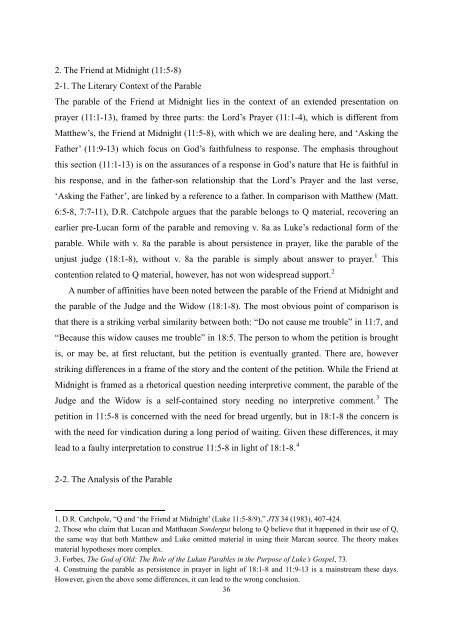the role of the lukan parables in terms of the purpose of luke's gospel
the role of the lukan parables in terms of the purpose of luke's gospel
the role of the lukan parables in terms of the purpose of luke's gospel
Create successful ePaper yourself
Turn your PDF publications into a flip-book with our unique Google optimized e-Paper software.
2. The Friend at Midnight (11:5-8)<br />
2-1. The Literary Context <strong>of</strong> <strong>the</strong> Parable<br />
The parable <strong>of</strong> <strong>the</strong> Friend at Midnight lies <strong>in</strong> <strong>the</strong> context <strong>of</strong> an extended presentation on<br />
prayer (11:1-13), framed by three parts: <strong>the</strong> Lord’s Prayer (11:1-4), which is different from<br />
Mat<strong>the</strong>w’s, <strong>the</strong> Friend at Midnight (11:5-8), with which we are deal<strong>in</strong>g here, and ‘Ask<strong>in</strong>g <strong>the</strong><br />
Fa<strong>the</strong>r’ (11:9-13) which focus on God’s faithfulness to response. The emphasis throughout<br />
this section (11:1-13) is on <strong>the</strong> assurances <strong>of</strong> a response <strong>in</strong> God’s nature that He is faithful <strong>in</strong><br />
his response, and <strong>in</strong> <strong>the</strong> fa<strong>the</strong>r-son relationship that <strong>the</strong> Lord’s Prayer and <strong>the</strong> last verse,<br />
‘Ask<strong>in</strong>g <strong>the</strong> Fa<strong>the</strong>r’, are l<strong>in</strong>ked by a reference to a fa<strong>the</strong>r. In comparison with Mat<strong>the</strong>w (Matt.<br />
6:5-8, 7:7-11), D.R. Catchpole argues that <strong>the</strong> parable belongs to Q material, recover<strong>in</strong>g an<br />
earlier pre-Lucan form <strong>of</strong> <strong>the</strong> parable and remov<strong>in</strong>g v. 8a as Luke’s redactional form <strong>of</strong> <strong>the</strong><br />
parable. While with v. 8a <strong>the</strong> parable is about persistence <strong>in</strong> prayer, like <strong>the</strong> parable <strong>of</strong> <strong>the</strong><br />
unjust judge (18:1-8), without v. 8a <strong>the</strong> parable is simply about answer to prayer. 1 This<br />
contention related to Q material, however, has not won widespread support. 2<br />
A number <strong>of</strong> aff<strong>in</strong>ities have been noted between <strong>the</strong> parable <strong>of</strong> <strong>the</strong> Friend at Midnight and<br />
<strong>the</strong> parable <strong>of</strong> <strong>the</strong> Judge and <strong>the</strong> Widow (18:1-8). The most obvious po<strong>in</strong>t <strong>of</strong> comparison is<br />
that <strong>the</strong>re is a strik<strong>in</strong>g verbal similarity between both: “Do not cause me trouble” <strong>in</strong> 11:7, and<br />
“Because this widow causes me trouble” <strong>in</strong> 18:5. The person to whom <strong>the</strong> petition is brought<br />
is, or may be, at first reluctant, but <strong>the</strong> petition is eventually granted. There are, however<br />
strik<strong>in</strong>g differences <strong>in</strong> a frame <strong>of</strong> <strong>the</strong> story and <strong>the</strong> content <strong>of</strong> <strong>the</strong> petition. While <strong>the</strong> Friend at<br />
Midnight is framed as a rhetorical question need<strong>in</strong>g <strong>in</strong>terpretive comment, <strong>the</strong> parable <strong>of</strong> <strong>the</strong><br />
3<br />
Judge and <strong>the</strong> Widow is a self-conta<strong>in</strong>ed story need<strong>in</strong>g no <strong>in</strong>terpretive comment. The<br />
petition <strong>in</strong> 11:5-8 is concerned with <strong>the</strong> need for bread urgently, but <strong>in</strong> 18:1-8 <strong>the</strong> concern is<br />
with <strong>the</strong> need for v<strong>in</strong>dication dur<strong>in</strong>g a long period <strong>of</strong> wait<strong>in</strong>g. Given <strong>the</strong>se differences, it may<br />
lead to a faulty <strong>in</strong>terpretation to construe 11:5-8 <strong>in</strong> light <strong>of</strong> 18:1-8. 4<br />
2-2. The Analysis <strong>of</strong> <strong>the</strong> Parable<br />
1. D.R. Catchpole, “Q and ‘<strong>the</strong> Friend at Midnight’ (Luke 11:5-8/9),” JTS 34 (1983), 407-424.<br />
2. Those who claim that Lucan and Matthaean Sondergut belong to Q believe that it happened <strong>in</strong> <strong>the</strong>ir use <strong>of</strong> Q,<br />
<strong>the</strong> same way that both Mat<strong>the</strong>w and Luke omitted material <strong>in</strong> us<strong>in</strong>g <strong>the</strong>ir Marcan source. The <strong>the</strong>ory makes<br />
material hypo<strong>the</strong>ses more complex.<br />
3. Forbes, The God <strong>of</strong> Old: The Role <strong>of</strong> <strong>the</strong> Lukan Parables <strong>in</strong> <strong>the</strong> Purpose <strong>of</strong> Luke’s Gospel, 73.<br />
4. Constru<strong>in</strong>g <strong>the</strong> parable as persistence <strong>in</strong> prayer <strong>in</strong> light <strong>of</strong> 18:1-8 and 11:9-13 is a ma<strong>in</strong>stream <strong>the</strong>se days.<br />
However, given <strong>the</strong> above some differences, it can lead to <strong>the</strong> wrong conclusion.<br />
36
















